How to Optimize a Warehouse Layout: Space vs. Worker Efficiency
The statement, “As long as there are racking systems in my warehouse, everything will run smoothly,” may provide a sense of comfort, but it oversimplifies a complex issue. Did you know that poorly designed warehouse layouts using racking systems can lead to a staggering 30% decrease in operational efficiency compared to having no racking at all?
For warehouse managers, the challenge lies not just in having racking but in strategically designing your warehouse layout to maximize both storage space and worker productivity. With two primary approaches to racking layout design—Space Optimization and Worker Optimization—the choices you make can significantly impact your bottom line and employee satisfaction. This article explores these approaches and their implications for warehouse operations.
What is a Space-Optimized Warehouse Layout?
A space-optimized warehouse layout focuses on maximizing the use of available space. High-density racking systems enable you to store more inventory without the need for additional square footage, allowing for greater product capacity within the same facility.
Benefits of Worker Optimization:
- Higher Storage Capacity: By strategically arranging your racking systems, you can significantly enhance your storage capacity. Properly designed layouts allow for the storage of more items within the same footprint, increasing operational efficiency.
- Cost Savings: With rising real estate costs, effectively utilizing your existing space can lead to substantial savings. Storing more without requiring additional space helps keep your budget in check.
- Better Inventory Management: An organized warehouse with designated storage locations simplifies inventory tracking. This organization reduces the risk of overstocking or running out of essential items.


What is a Worker-Optimized Warehouse Layout?
A worker-optimized warehouse layout prioritizes employee comfort and accessibility. This approach incorporates ergonomic racking systems and adjustable shelving to enhance the efficiency and well-being of your workforce.
Benefits of Worker Optimization:
- Increased Productivity: When workers have quick access to the items they need, they can fulfill orders more efficiently, leading to higher overall productivity.
- Enhanced Job Satisfaction: A comfortable work environment contributes to employee happiness. Reduced fatigue translates to increased motivation and lower turnover rates.
- Improved Safety: Streamlining movement within the warehouse not only boosts efficiency but also enhances workplace safety for your team.


Which Approach Delivers the Best Warehouse Layout?
So, how do you choose? It ultimately depends on your warehouse’s goals. If your priority is storage, a space-optimized layout might be your best bet. But if you want to ensure your team’s morale and productivity, consider a worker-optimized approach.
How to Optimize a Warehouse Layout: Best Practices
Here are some best practices to help you create an effective warehouse layout:
- Conduct Needs Assessments: Take a moment to evaluate your warehouse’s unique storage needs and how your team interacts with the space. What challenges do they face daily?
- Engage Workers in Planning: Your employees are on the front lines. Their insights can reveal pain points you might not be aware of, leading to a layout that works for everyone.
- Evaluate Racking Options: Choose racking systems that align with your layout goals—whether you’re leaning towards space or worker optimization.
- Calculate Costs: Keep a close eye on costs associated with your racking systems to ensure you’re staying within budget.
Real-World Examples of Warehouse Layouts
- Space-Optimized Case Study: A regional grocery distributor implemented a high-density drive-in racking system, allowing them to significantly increase storage capacity. By utilizing every inch of available vertical space and maximizing pallet positions, they were able to store 30% more inventory within the same footprint. This space optimization led to a notable reduction in rental costs and improved overall inventory management. While the layout was highly efficient for storage, it required workers to adapt to a more strategic picking process, which was manageable given the overall gains in capacity and cost savings.
- Worker-Optimized Case Study: A major e-commerce fulfillment center decided to overhaul its layout by investing in adjustable shelving and ergonomic workstations. This design choice focused on ease of access and comfort for employees. Workers reported feeling more energized and engaged with their tasks, resulting in a 20% increase in productivity. The thoughtful design reduced the time it took to locate items and pick orders, leading to faster order fulfillment and happier employees. This example demonstrates how prioritizing worker needs can lead to both improved morale and significant operational gains.
What Would Hyperack Do Instead?
At Hyperack, we get it—choosing space optimization or worker comfort is no small feat. That’s why we leverage multiple options to create tailored racking warehouse layouts that meet both needs. Here’s what makes us different:
- Expertise: We dive deep into your warehouse space to determine the best racking configurations tailored to your needs.
- High-Tech Solutions: Our AutoCAD designs maximize storage while ensuring your team has ergonomic access to what they need.
- Side-by-Side Comparisons: Our planning process allows you to compare layout options easily, helping you make informed decisions.
- Data-Driven ROI Calculation: We provide detailed numerical data for each layout, empowering you to understand the impact on your bottom line.
- Customization: Our custom racking systems are built to meet your unique requirements, ensuring the best approach for your facility.
With Hyperack, you won’t have to choose between efficiency and worker satisfaction—we help you achieve
Conclusion
Finding the right balance between space optimization and worker efficiency in your warehouse layout is essential. While maximizing storage can yield immediate benefits, overlooking your team’s needs can lead to long-term consequences on productivity and morale. By understanding both approaches and their impacts on your workforce, you can create an efficient and enjoyable work environment. Remember, happy workers lead to a successful operation!


